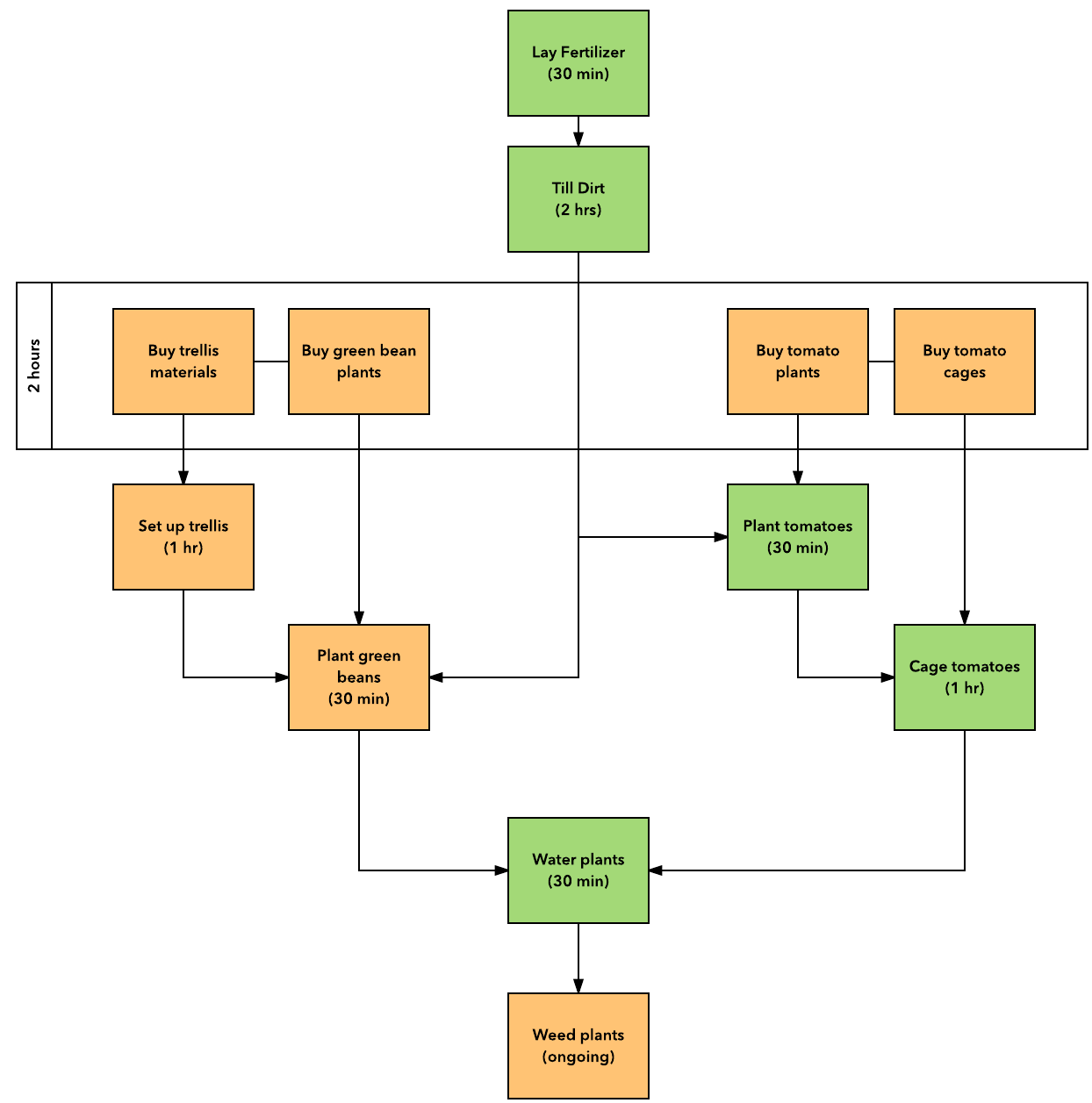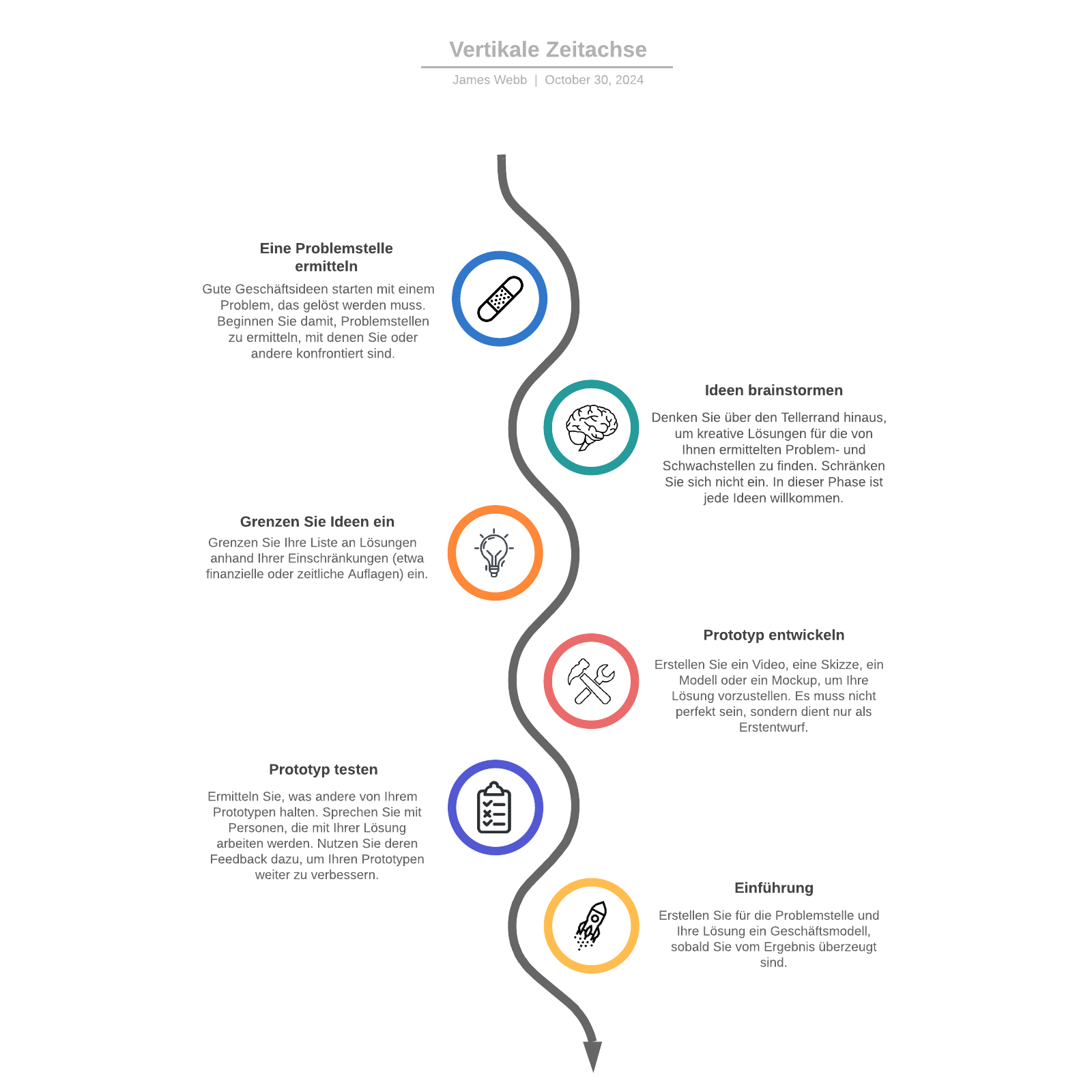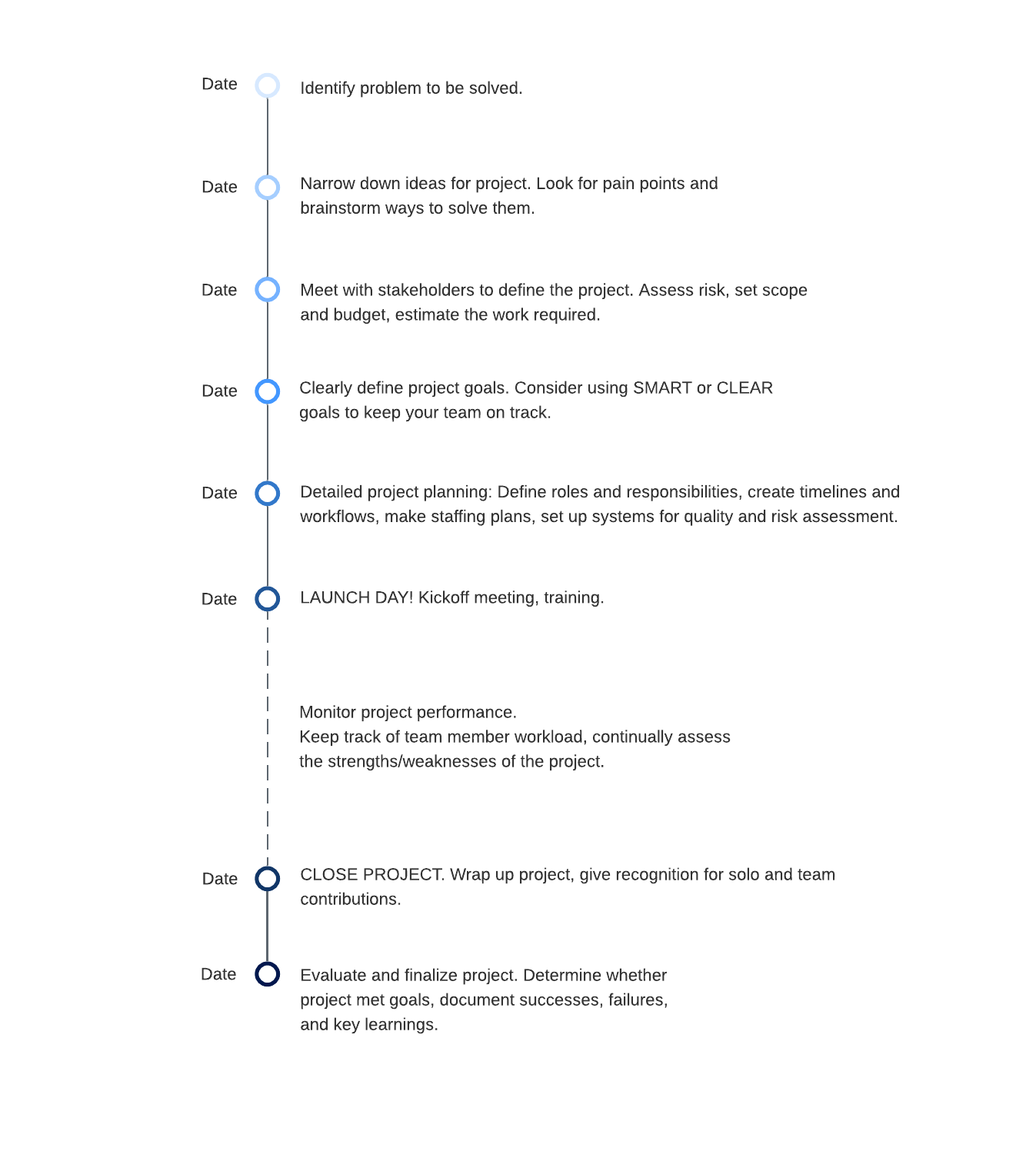Content
Content
No project plan or charter is complete without a project management timeline. Project management timelines provide a simple visual overview of a project from start to finish and lead to increased work efficiency among teams.
As simple as timelines appear when you see them on paper, breaking down a project into an effective timeline may feel overwhelming, especially to novice project managers. So, if this is your first experience creating a project management timeline, or even your 563rd, use these eight no-fail steps to perfect your next timeline.
1. Write a project scope statement
Before you can create your project timeline, you'll need to determine the scope of your project. A project scope statement outlines the deliverables you plan to produce by the end of a project.
As a quick example, let’s say you and your friends want to plant a garden. A scope statement could look something like this: We will produce a 100 sq ft vegetable garden that produces tomatoes, peppers, kale, potatoes, peas, green beans, and corn.
2. Create a work breakdown structure (WBS)
To create a work breakdown structure (WBS), start with your scope statement and break your deliverables or deliverables into smaller pieces. You aren’t getting into tasks yet, just smaller deliverables. Another name for this section is the scope baseline, and each sub-deliverable is called a work package.
Continuing with our garden example, you could say that your WBS is to produce:
- 10 sq ft of tomatoes
- 10 sq ft of peppers
- 15 sq ft of kale
- 20 sq ft of potatoes
- 15 sq ft of peas
- 10 sq ft of green beans
- 20 sq ft of corn
Here, each vegetable deliverable would be a work package.
3. Break each work package into tasks
Now you can make a to-do list for each work package. Think about the gap between your baseline and your goal. What needs to happen to get from the starting point to the desired end point? Take note of tasks that are similar across work packages. This process will help you determine dependencies in the next step.
Now make a task list for two of your mini garden work packages and organize them in a table. For example, under “10 sq ft of tomatoes,” you may include till ground, fertilize dirt, buy cages, etc.

4. Determine project dependencies
Dependencies are tasks that cannot be started until another task has been completed. For example, you can’t plant your tomatoes until after the ground has been tilled. In this scenario, determining dependencies for a project management timeline will be relatively straightforward, but for more complex processes, mapping dependencies might give you a few gray hairs.
Consider creating a flowchart or diagram to visualize and identify these dependencies. You may find it helpful to use swimlanes or color coding to designate which team or individual will take responsibility for each task. Here, the work of planting tomatoes and green beans is split into two teams by color:

5. Determine total time needed for each task
Go back to your task list or dependency chart and consider how long it will take to accomplish each task. Assume that the responsible party is working diligently on the task without interruptions. If you are unable to accurately estimate the needed time, work on this section with an expert who can give you some guidance.
The example below includes a swimlane to show that all of the buying tasks will be done together.


For help with finding dependencies and determining how long your project will take, consider the critical path method.
Learn how

Ready to get started? Timelines make it easy to keep the entire project on track. Give stakeholders a realistic projection for the project and communicate expectations.

Clarify deadlines and keep projects on track using our timeline maker.
Learn how6. Identify resource availability
Most often, your limiting resource will be the availability of your team members or employees. In this step, you need to consider when they will be able to spend time working on an allotted task. Even though it may only take a day of dedicated work to complete an assignment, you may need to expand the amount of designated time to a few days or even weeks if there are many other projects occurring simultaneously.
In the garden example, it will only take four hours from start to finish, but with everything else going on, your team will need two weekends to get it done. Therefore, when you create a project timeline, you will reserve several days for each task.
7. Identify important milestones
Project milestones mark project achievements along the way, allowing you to track the progress of your projects from start to finish. This way, if you get behind, you will know far in advance of your final deadline and be able to adjust your plans or expectations to stay on target.
Milestones can mark project phases or large tasks, or you can measure them by the percentage or portion of the project completed.
8. Build your project management timeline
This is the fun part! It's time to create your project timeline. Line your tasks end to end, adjust their lengths to reflect the amount of time allotted, and then add milestones to polish things off. Voilà! You have a completed project management timeline. Isn’t it beautiful?

Pro tips
To optimize your experience creating project management timelines, here are a few tips:
- Before anything else, set the start and end date of the project and adjust your labels. This will help you make your provisional schedule.
- Next, decide whether you are using a line or a block timeline. Use the structure that best fits your project. Basic line timelines help identify key milestones, where block timelines make it easy to visualize teams and specific task progress.
- Label the labels of your project based on the timeline. Labels can be in seconds, hours, days, weeks, or even years.
- Stack multiple timelines so that labels only appear on the bottom timeline.
- Color-code the different timelines or rows to organize the project and keep everyone on the same page.
- Alter intervals, but only in complete increments.
If you decide to build your project management timeline in Lucidchart, visit our project management template library for other project tracking ideas.
Project management timeline templates
Use these project management timeline templates to get you started!
About Lucidchart
Lucidchart, a cloud-based intelligent diagramming application, is a core component of Lucid Software's Visual Collaboration Suite. This intuitive, cloud-based solution empowers teams to collaborate in real-time to build flowcharts, mockups, UML diagrams, customer journey maps, and more. Lucidchart propels teams forward to build the future faster. Lucid is proud to serve top businesses around the world, including customers such as Google, GE, and NBC Universal, and 99% of the Fortune 500. Lucid partners with industry leaders, including Google, Atlassian, and Microsoft. Since its founding, Lucid has received numerous awards for its products, business, and workplace culture. For more information, visit lucidchart.com.
Related articles
8 templates for project managers
In this blog post, we will share eight templates that project managers can use right now.
How to make a timeline in Word
Timelines allow you to show past events and future plans in a visual, scannable way. Now you can easily pair timelines with other documentation with Lucidchart and its Microsoft Word integration. Learn how to make a timeline in Word (it only takes 5 steps).
The best tips for project managers of remote teams
Learn how to import, manage, and monitor data in Lucidchart. Includes a free data visualization course!
Better ways to monitor and communicate your project's progress
In this article, you’ll learn tips and tricks to communicate your projects progress across teams and stakeholders.

